Pomegranate season is typically very short–running from September through December. With the season coming to an end, we need to preserve all the uneaten pomegranates sitting on our counters! This winter season, try making homemade pomegranate jelly. Our pomegranate jelly recipe balances the natural tartness of the fruit with the sweetness of the sugar in the preservation process.
Pomegranate jelly keeps on your shelves all year long. You can use our jelly as a spread for breads, scones, and muffins. It can also be used in baked goods as a jelly layer in a cake, on top of pressed cookies, and more!

Also, if you are looking for DIY gifts this holiday season, try giving homemade jelly, jams, and preserves. They have a long-lasting shelf life, so the giftee will not be pressured to eat it right away! If you need other gift ideas check out our Holiday Foodie Gift Guide!
What Is the Difference Between Jam and Jelly ?
Jam: a thick spread made predominantly from fruit juice, fruit (chopped, smushed, or pureed), and sugar. With the help of pectin, jams thicken but remain looser than their jelly counterpart. Jams are not transparent as they contain fruit pulp.
Jelly: a transparent fruit spread made from cooking fruit juice, sugar, and pectin together until the mixture gels and thickens. When using fresh fruit, the jelly is strained through a “jelly bag” to remove any solids before sealing into the jars. Typically, jelly is glossy and wobbly when properly set.

Pomegranate Jelly Ingredients:
Fo our recipe, the ingredients include:
- Pomegranate Juice
- Pectin
- Butter
- Sugar; and
- Lemon Juice
Before getting to the recipe, I want to answer a few potential questions regarding some of the ingredients. While researching pomegranate jelly, I found there were many questions about pomegranate juice and pectin. Finally, I learned a trick from the blog “The Flour Handprint” regarding the use of butter. So, let’s get started:
Pomegranates:
When looking on cooking forums, websites, and other blogs, I saw a recurring question: Do I need to use fresh pomegranate fruit to make pomegranate jelly?
While using fresh pomegranates is the preferred option if you have them on hand, it is not necessary. You can make pomegranate jelly using juice from the grocery store.
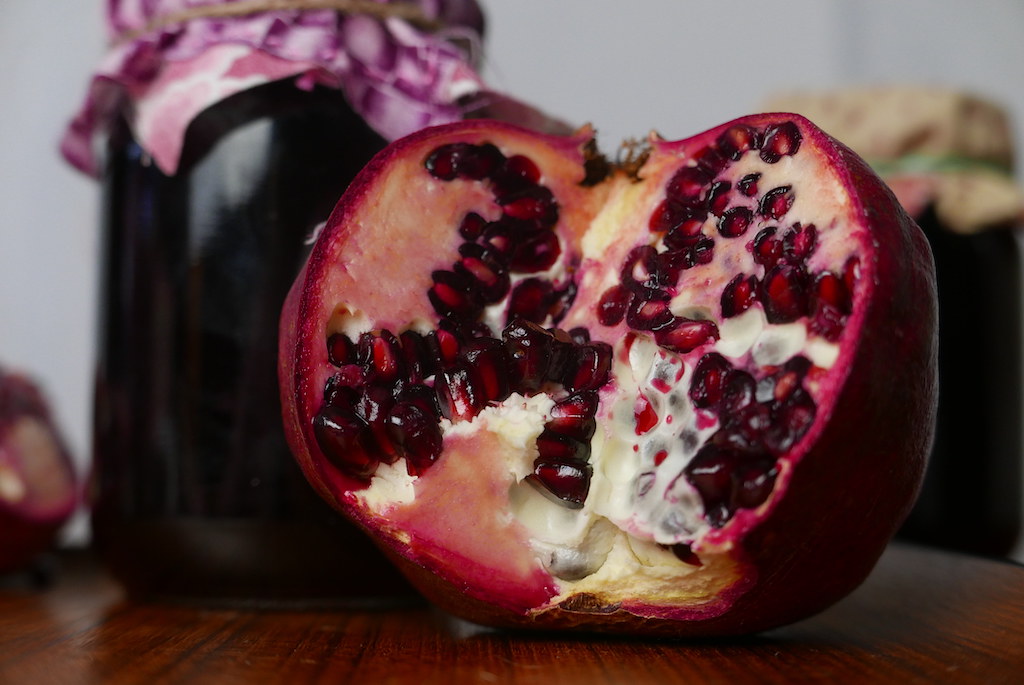
If you have access to a pomegranate tree, as the fruit ripens, you can easily make jars and jars of fresh pomegranate jelly. Unfortunately, without that easy access, making pomegranate jelly can be incredibly expensive from fresh fruit. Because the pomegranate season is so short, the price for a few fruits at the store can be exorbitant.
One pomegranate fruit produces approximately half a cup of juice. That means you will need ten fruits for our recipe. As of December 8th, 2020, our grocery store is selling two pomegranates for $6 on promotion. That means you will be paying $30 to make a few jars of jelly. Remember, this is before calculating the cost of sugar, pectin, and jars.
Instead, simply buy a container of pomegranate fruit juice. You will save at least twenty dollars! If you use pomegranate juice, please go to the refrigerator section of the store and buy 100% pomegranate juice. If you go to the center aisles, you can find juice but it will unfortunately have added sugar and preservatives to keep the juice fresh for long periods unrefrigerated. If you get that, your pomegranate jelly will be SO SWEET after adding in the necessary sugar in the jelly making process.
Pectin:
The next recurring question: Do I need to use pectin to make pomegranate jelly?
First, what is pectin? Pectin is a soluble and gelatinous polysaccharide. Pectin naturally occurs in ripe fruits–typically the highest levels exist in the skins, seeds, and cores of fruit. We extract it to use as a setting agent in preserves such as jams and jellies.
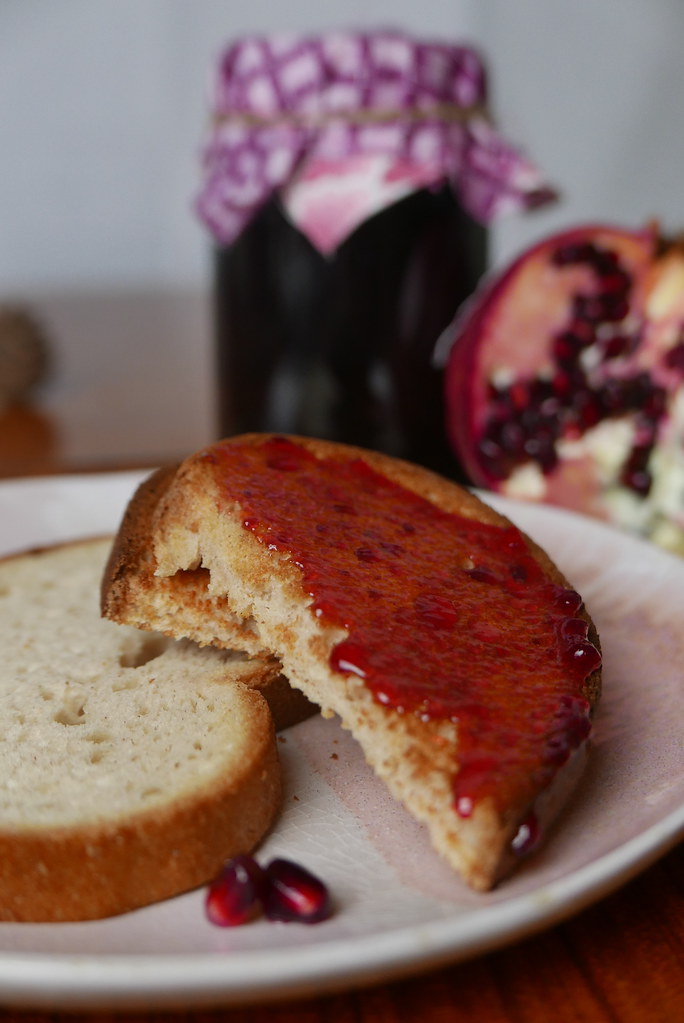
While jams, marmalades, and preserves use the skins and flesh of the fruit, jelly does not. So, even though pectin already exists in fruit, the fruit juice itself does not always contain enough to set properly.
The process of making jelly without store-bought pectin is incredibly time consuming. You need to cook the fruit into jelly, let the jelly separate from solids overnight using a jelly bag, and then cook the jelly again to set the mixture. It takes hours and at least two days to complete. While I am willing to go through the hassle when making jam and preserves, as you keep the fruit pieces in the mixture, I am not for jelly! It is a pain!
Pectin allows you to skip the use of skins, seeds, and cores of fruit when making jelly. Instead, store-bought pectin is a dry powder you add to the fruit juice during the boiling process.
Butter:
I learned this cool trick from Mikayla’s blog “The Flour Handprint.” When boiling your jelly during the second boil, it naturally creates bubbles on the surface. It is natural and edible but ruins the transparent nature of jelly when jarred. Somehow, miraculously, adding a little butter during the first boil significantly reduces the amount of bubbles in the second boil.
Though it won’t completely rid you of the bubbles, it reduces them into a thin, easily skim-able layer. Such a good jelly hack!
Canning and Jarring Safety When Making Pomegranate Jelly:
When canning and jarring, it is important to go through the necessary steps to kill any bacteria that may cause you bodily harm. In other words, you need to sterilize the jar. Sterilizing keeps bacteria from growing in your food.
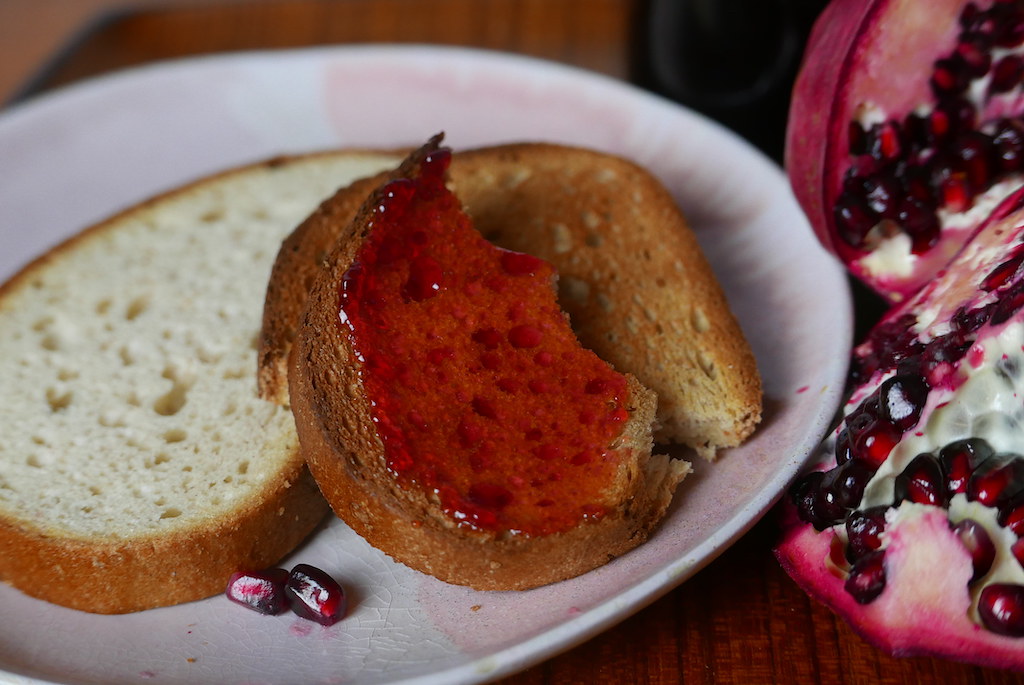
How to Prep Your Jars:
- Fill a large pot with water. Place the pot on the stove and bring to a rapid boil on high.
- While the pot is coming to a boil, prepare a clean towel on a flat, cleared space.
- Once the pot is boiling, place the lids and jars into the water. The lids should not be screwed onto the jar. Instead, they need to be separate.
- Leave the jars and lids in the boiling water for 5 minutes. Remove the jars from the boiling water using a set of tongs and place them onto the clean towel to dry and cool down slightly. Do not move off the towel or touch until you are ready to start jarring. This way, they remain sterilized before you begin jarring.
Once you have sterilized your jar, you are ready to begin making your jelly. I recommend preparing your canning jars right before starting your jelly. Otherwise, you will be juggling too many things at once.

Second Jar Boil:
Once your jelly is in your jars, it is time to boil and seal your jars a second time. This way, the jars seal properly, and any bacteria introduced during the jarring process are killed off once again. Simply submerge your sealed jars of pomegranate jelly into boiling water. Let them sit for 10 minutes in the water. Once finished, remove your jelly, dry the canning jars off, and let them cool on the counter.
Once the jars cool, the lids should be properly sealed. Check the seal before giving as a gift or consuming. If you press on the jar lid, it should not click or move. If it does, the jar was not properly sealed and is not safe to consume. Once again, bacteria can get into your jars if they were not properly sealed.
Have You Ever Made Homemade Jelly, Jam, or Preserves?
Once you properly sanitize the jars, making homemade jelly, jam, and preserves is extremely simple and easy to do. Have you ever made homemade canned or jarred goods at home? If so, we would love to hear about your recipes, tips, tricks, and hacks to making jarred goods at home!
Below are some items that can help you start canning and jarring. These items include: jars, pectin, a canning funnel, and tongs! We hope you have fun making jellies and jams!
Let Us Know if You Like Our Pomegranate Jelly
We love hearing from you! Reach out to us via our email [email protected]. You can also follow us at @carvingajourney on Instagram, Twitter, Facebook, and Pinterest. Finally, you can subscribe to our blog by joining our mailing list.
Carving A Journey is a participant in the Amazon Services LLC Associates Program, an affiliate advertising program designed to provide a means for sites to earn advertising fees by advertising and linking to Amazon.com. Although we may earn commissions for our endorsement, recommendation, testimonial, and/or link to any products or services from this website, these opinions are my own and I fully support these products.

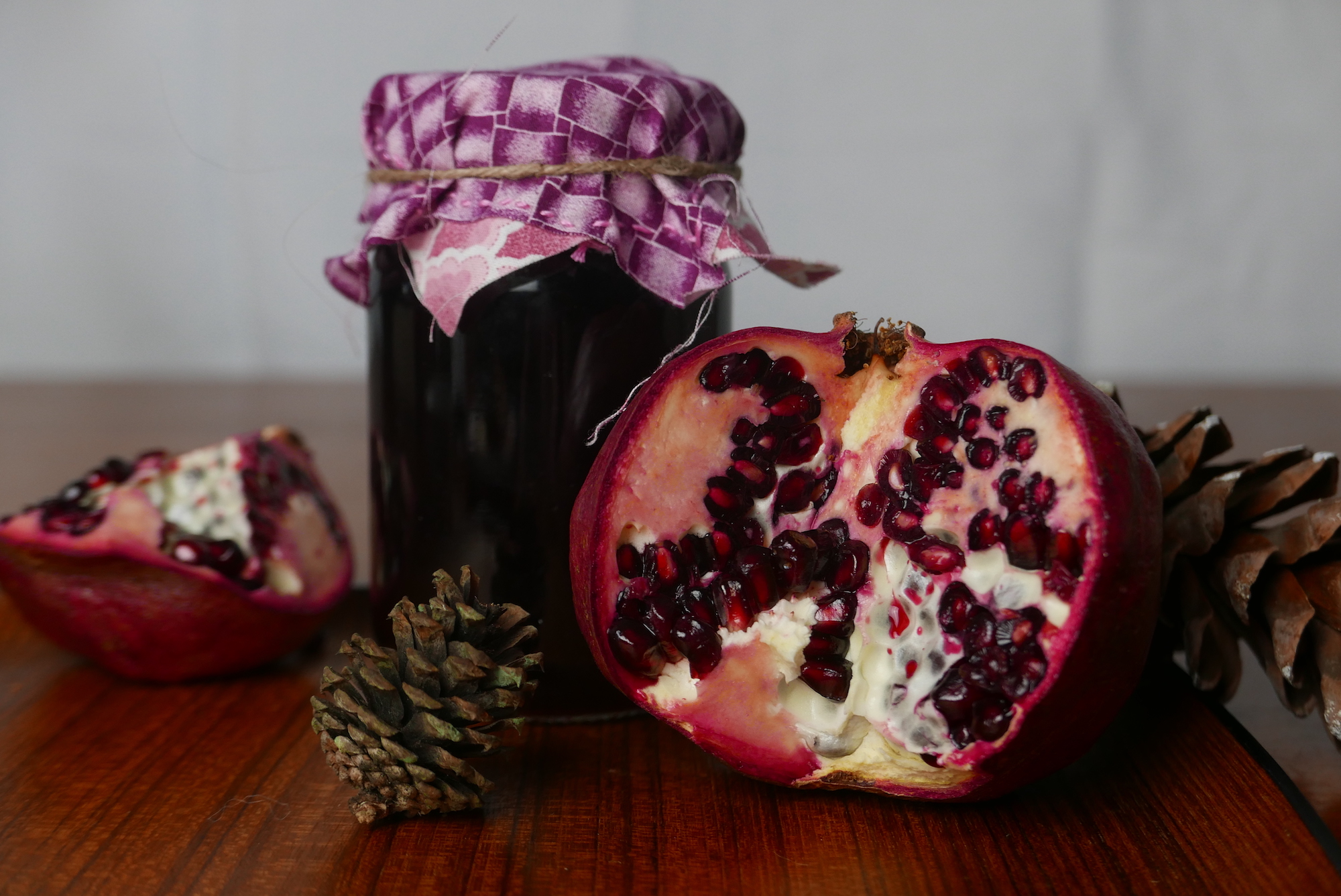
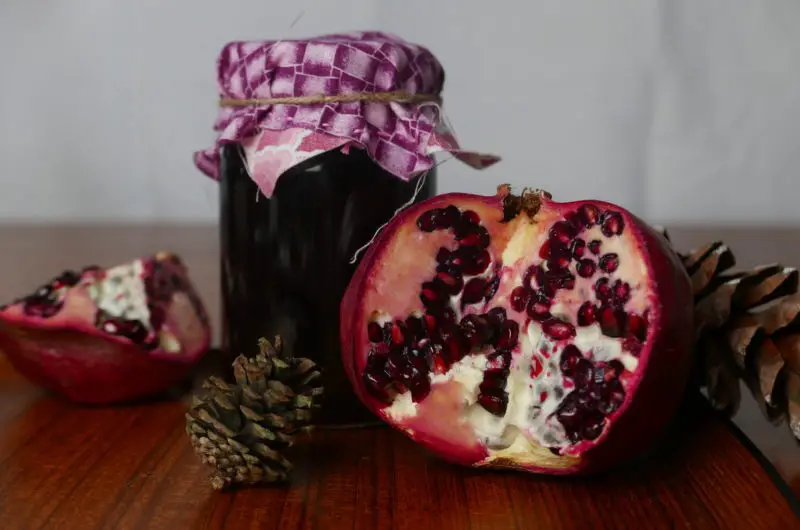
2 comments
Looks yummy ! Bring some to us next time u come to Savannah! Love, Pie pie and M!
I can’t wait to try this. Beautiful pics!!!